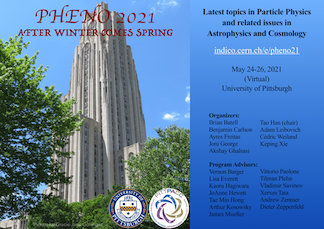Conveners
BSM VII
- Christian Herwig (Fermi National Accelerator Lab. (US))
The recent results from the LHC suggest that the next search for New Physics should be performed in the low-energy mass range using high-intensity beams. That has revived the interest in the phenomenology of new light particles with feeble interactions with the Standard Model[1]. The DOE in the US is perfectly positioned for that quest with four laboratories (FNAL, ORNL, BNL, and LANL) capable...
The FASER experiment is a new small and inexpensive experiment that is being placed 480 meters downstream of the ATLAS experiment at the CERN LHC. The experiment will shed light on currently unexplored phenomena, having the potential to make a revolutionary discovery. FASER is designed to capture decays of exotic particles, produced in the very forward region, out of the ATLAS detector...
A modest extension of the Standard Model by two additional Higgs doublets - the Higgs Troika Model - can provide a well-motivated scenario for successful baryogenesis if neutrinos are Dirac fermions. Adapting the "Spontaneous Flavor Violation" framework, we consider a version of the Troika model where light quarks have significant couplings to the new multi-TeV Higgs states. Resonant...
Electroweak symmetry non-restoration up to high temperatures well above the electroweak scale has intriguing implications for (electroweak) baryogenesis and early universe thermal histories. In this talk, I will discuss a new approach for electroweak symmetry non-restoration via an inert Higgs sector that couples to the Standard Model Higgs as well as an extended scalar singlet sector....
Novelty detection is a task of Machine Learning to detect novel events without a prior knowledge. Its techniques can be applied to detect unexpected signals of new physics at colliders. We generalize the complementary strategies developed in the paper (arxiv:1807.10261) for achieving this task. Generally, the novelty evaluators are classified into two categories: isolation-based and clustering...
The simplified limits framework is an approach developed to recast limits on searches for narrow resonances in terms of products of branching ratios (BRs) corresponding to the resonance's production and decay modes. In this talk, we will present an extension of the framework to a multidimensional parameter space of BRs. This can be used in a model-independent way to unfold an ambiguity in the...
I will discuss the correlation between dark matter and Higgs decays in gauge theories where the dark matter is predicted from anomaly cancellation. In these theories, the Higgs responsible for the breaking of the gauge symmetry generates the mass for the dark matter candidate. We investigate the Higgs decays in the minimal gauge theory for Baryon number. After imposing the dark matter density...
Two Higgs Doublet Model (2HDM) offers a prototype beyond the Standard Model (SM) with an extended Higgs sector. It provides a rich spectrum of scalars, of which some can be relatively light with weak couplings to the SM particles. Complementary to the usual searches for extra scalars at high energy colliders, FASER offers a unique opportunity to study those relatively long-lived light scalars....
Results on rare and new top quarks interactions, including EFT, in CMS
